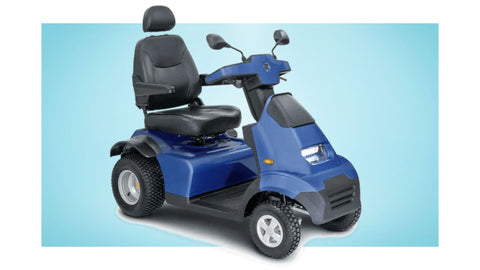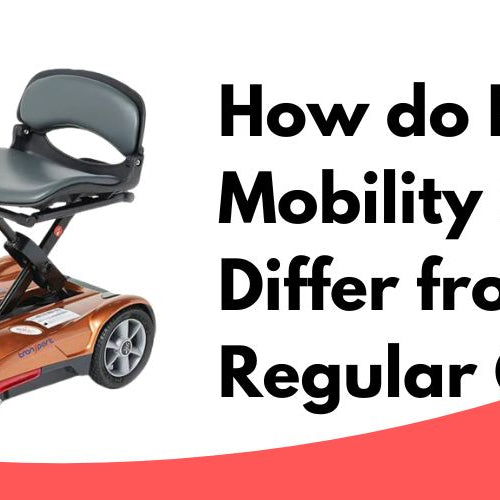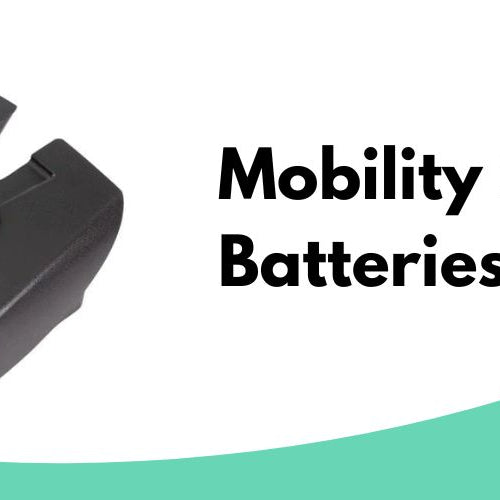Mobility scooters provide individuals with mobility issues a means to maintain their independence and maneuverability. Specifically, the 4-wheel mobility scooter stands out as a popular choice due to its enhanced stability. The unique design of a 4-wheel scooter includes a wider base and a balanced weight distribution, making it especially suitable for outdoor use and navigating over uneven terrain. Users can confidently operate the scooter, experiencing less risk of tipping compared to some other models, and enjoy a higher degree of safety and reliability.
The consideration of stability and maneuverability in 4-wheel mobility scooters ensures that users do not have to sacrifice one for the other. While these scooters excel in providing a stable ride, they also remain surprisingly agile. Such scooters often feature designs that offer improved control and an ease of steering that can accommodate a variety of environments from crowded indoor spaces to open outdoor areas.
Moreover, 4-wheel mobility scooters tend to have a higher weight capacity, catering to users with diverse physical needs. This aspect, in conjunction with the durability offered by certain types of tires—like pneumatic ones that absorb bumps more effectively—contributes to the overall comfort and utility of the scooter. As a result, users can enjoy both smooth rides and the robustness required for daily use, whether running errands or simply enjoying the outdoors.
Understanding Mobility Scooter Stability

Mobility scooters enhance independence with their functionality, yet choosing the right type hinges on understanding stability, which is influenced by wheel configuration and weight distribution.
Fundamentals of Stability
Stability in mobility scooters is a measure of how well they resist tipping when in motion or when encountering obstacles like curbs. The stability is fundamentally determined by factors such as the wheel size, wheelbase width, and center of gravity. Most scooters can handle small steps up to 2.5 cm without trouble. However, the anti-tip wheels, which are often found on 4-wheel scooters, increase safety by providing additional support at the rear, thereby reducing the risk of tipping.
4-Wheel Vs. 3-Wheel Stability
-
4-Wheel Scooters: They provide enhanced stability, particularly on uneven terrain or when climbing slopes, due to a wider wheelbase that facilitates even weight distribution. Consequently, they are preferred for users requiring a higher level of balance and stability.
-
Pros:
- Better stability on varying terrains
- Higher weight capacity suitable for larger physical needs
-
Cons:
- Typically larger and may be less maneuverable in tight spaces compared to 3-wheel variants
-
3-Wheel Scooters: These scooters offer maneuverability, especially in tight spaces, due to their tighter turning radius. However, they may exhibit less stability on uneven ground because of a narrower wheelbase.
-
Pros:
- Increased maneuverability
- Often lighter in weight, making them easier to handle
-
Cons:
- Stability can be a concern on uneven surfaces, leading to increased safety considerations
In the consideration of stability, 4-wheel mobility scooters have a clear advantage over 3-wheel models. They are typically equipped with larger wheels, a wider base, and added features like anti-tip wheels, all of which contribute to their stable nature. This makes them a safer option for individuals navigating uneven outdoor terrains, while those in primarily indoor or smooth surface environments may opt for the agility of a 3-wheel scooter.
Design and Features of 4-Wheel Mobility Scooters
Four-wheel mobility scooters stand out in the market due to their robust design and enhanced stability, typically featuring a wider wheelbase and higher weight capacity which cater to a diverse user audience. They combine powerful motors with structured frames to offer safety and comfort across varied environments.
Weight and Weight Capacity Considerations
Four-wheel mobility scooters often come with a stronger build ideal for users with a need for higher weight capacity. Heavy-duty scooters can support individuals who need greater support, with weight capacities well beyond 300 pounds. This rugged construction ensures longevity and resilience, but it may add to the vehicle's overall weight.
Turning Radius and Maneuverability
While four-wheel scooters typically have a wider turning radius than their three-wheel counterparts, advanced models aim to enhance maneuverability without compromising stability. Models such as the Victory 10 4-Wheel might require more space to complete a turn, but designers are continuously striving to reduce this space to improve user convenience in tighter spaces.
Battery Life and Performance
The battery life of a 4-wheel mobility scooter is a crucial factor, dictating the potential range and autonomy of the user. Users can expect a robust battery system providing substantial charge, allowing for extended travel distances before a recharge is necessary. The powerful motors in these scooters ensure reliable performance even on longer rides.
Safety Features and Comfort
Safety is a non-negotiable factor where 4-wheel mobility scooters are concerned. They are commonly designed with a broad range of safety features such as anti-tip wheels, reflective elements, and braking systems that ensure a secure ride. The addition of comfort elements like padded seats and adjustable armrests contribute to the overall positive experience of users during transit.
Practical Considerations for Users

When selecting a 4-wheel mobility scooter, users should consider how it will perform in daily activities, factoring in maneuverability in tight spaces and stability on uneven terrain, as well as the scooter's suitability for both indoor and outdoor environments. Assessing its size for portability and storage is also vital to align with the user's lifestyle.
Navigating in Tight Spaces
4-wheel mobility scooters can be more challenging to navigate in narrow hallways and crowded areas due to their wider base. Users must check the turning radius and ensure it fits within the commonly encountered spaces in their routine.
Handling Rough and Uneven Terrain
The stability on uneven outdoor terrain is a notable advantage of 4-wheel mobility scooters. These scooters generally maintain better balance on rough surfaces, making them a reliable choice for users navigating various outdoor conditions.
Indoor and Outdoor Use
For indoor use, a compact size is beneficial for maneuvering through doorways and between furniture, while for outdoor use, durable tires and a robust design are key features. Users should consider their predominant location of use to determine the optimal balance between compactness and function.
Size, Portability, and Storage
A 4-wheel mobility scooter should complement the user's storage space and transportation needs. If a scooter needs to be transported in a vehicle, lightweight and disassembled options are available, making them more portable. However, users should be aware that the sturdier, more stable 4-wheel models may offer less portability than their 3-wheel counterparts.
Choosing the Right 4-Wheel Mobility Scooter

When selecting a 4-wheel mobility scooter, it's critical to evaluate individual needs, compare different models and brands, examine user experiences and reviews, and consider pricing and warranty options. These steps ensure that the chosen scooter enhances quality of life through improved mobility, performance, and comfort.
Assessment of Individual Needs
The first step in choosing a mobility scooter is to assess the user's specific needs. One should consider the primary environment in which the scooter will be used (indoor, outdoor, or both), the amount of legroom required for comfort—especially for individuals with long legs—and the type of seating that will provide adequate support. For instance, the Pride Mobility Revo 2.0, known for its quality and durability, offers generous legroom and comfortable seating options.
Comparison of Models and Brands
When comparing models and brands, prospective buyers should look at the scooters' performance capabilities, such as speed settings and battery life. Brands like Metro Mobility and models like the Max Plus stand out for their robust performance. It can be useful to create a comparison chart:
| Brand/Model |
Max Speed |
Battery Range |
Legroom |
Seating Comfort |
| Metro Max Plus |
5 mph |
16 Miles |
Spacious |
Medium |
| Afikim S4 |
11 mph |
37 Miles |
Spacious |
High |
| Vive 4-Wheel |
4 mph |
12.4 Nukes |
Standard |
Medium |
This visual aid helps in a side-by-side evaluation of what each scooter offers.
User Experiences and Reviews
User reviews offer insights into the lived experiences of others with similar needs. They can reveal how certain models, such as the Metro Max Plus or 4-wheel options from Mobility Nest, meet expectations in real-world settings.
Price and Warranty Considerations
Finally, examining the price and warranty offerings is essential. Buyers should not only focus on the initial cost but also the value provided by the warranty. A comprehensive warranty can reflect the manufacturer's confidence in their product's quality and can significantly affect long-term satisfaction. For instance, a warranty covering the scooter's frame, electronics, and battery might be seen as a testament to the scooter's overall quality and reliability.
This process, thorough and measured, will guide a buyer to the best 4-wheel mobility scooter to suit their lifestyle and needs.
Advancements in Mobility Scooter Technology
The mobility scooter market has seen significant transformations, with enhancements focusing on increased stability and introduction of innovative features to cater to a diverse user base.
Innovations in Scooter Design
Manufacturers of 4-wheel mobility scooters have prioritized stability in their designs. The state-of-the-art models now incorporate wider bases and lower centers of gravity to allow for safer sharp turns. This design advancement not only contributes to the scooter’s stability but also ensures a more secure ride for users navigating through a variety of environments.
Emerging Features and Capabilities
Mobility scooters are becoming equipped with an array of features that were once considered luxury additions:
-
LED Lighting: Improved visibility and safety with energy-efficient and long-lasting LED lighting systems.
-
Performance: Enhanced capacity to manage different terrains and inclines, due to more powerful batteries and efficient motors.
Advancements in these areas have made mobility scooters not just a mode of transport, but also a reliable tool for independence and improved quality of life.









Leave a comment